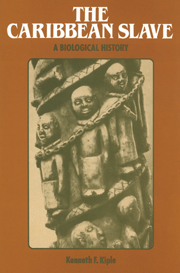Book contents
- Frontmatter
- Contents
- List of Tables
- Preface
- Acknowledgments
- Part I Background and Biology
- Part II Diet, Disease, and Demography
- Introduction
- 4 The Middle Passage and Malnutrition
- 5 Plantation Nutrition
- 6 Malnutrition: Morbidity and Mortality
- 7 Slave Demography
- 8 Slave Infant and Child Mortality
- 9 Black Diseases and White Medicine
- Part III Pathogens and Politics
- Notes
- Bibliographic Essay
- Index
7 - Slave Demography
Published online by Cambridge University Press: 19 October 2009
- Frontmatter
- Contents
- List of Tables
- Preface
- Acknowledgments
- Part I Background and Biology
- Part II Diet, Disease, and Demography
- Introduction
- 4 The Middle Passage and Malnutrition
- 5 Plantation Nutrition
- 6 Malnutrition: Morbidity and Mortality
- 7 Slave Demography
- 8 Slave Infant and Child Mortality
- 9 Black Diseases and White Medicine
- Part III Pathogens and Politics
- Notes
- Bibliographic Essay
- Index
Summary
Infant mortality [in the Leeward Islands] was in 1788 reckoned at about one-half the number of children born to slave women.
Elsa V. Goveia (1965)[It is an] astounding fact that while the slaves in the United States have increased tenfold, those of the…West Indies generally decreased in the proportion of five to two.
Josiah Clark Nott and George R. Gliddon (1857)As more specialized knowledge, especially that of a demographic nature, has been brought to bear on the study of slavery, the question of why most slave populations of the hemisphere failed to reproduce their numbers, while that of the United States grew at a brisk rate has become a central problem for those seeking a deeper understanding of New World slavery.
The problem of slave demography was also central for contemporary observers. Baron von Humboldt, for example, reported that, in early nineteenth-century Cuba, “I have heard discussed with the greatest coolness, the question of whether it was better for the proprietor not to overwork his slaves, and consequently have to replace them with less frequency, or whether he should get all he could out of them in a few years and thus have to purchase newly imported Africans more frequently.” Spanish authorities in Cuba believed that much of the failure of that island's slave population to grow stemmed from a tendency of planters to overwork slaves. For high slave mortality in turn created a continuing demand for fresh African cargoes, always weighted heavily in favor of males, and here they felt was the heart of the difficulty. The resulting imbalance of the sexes cut sharply into the potential for high slave fertility.
- Type
- Chapter
- Information
- The Caribbean SlaveA Biological History, pp. 104 - 119Publisher: Cambridge University PressPrint publication year: 1985

